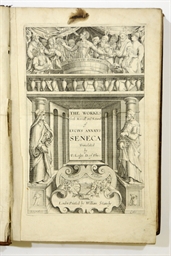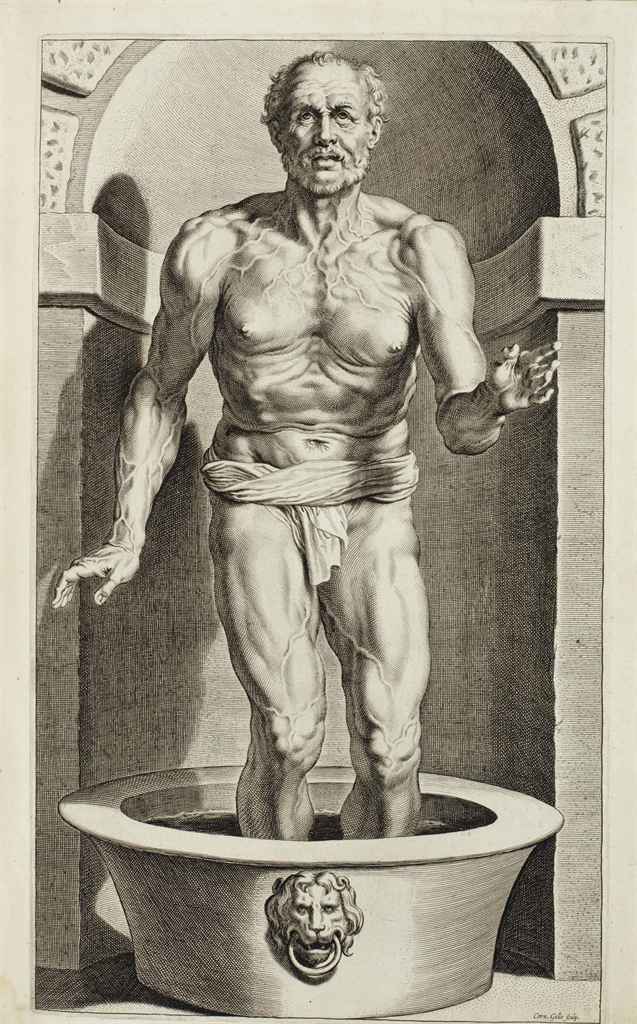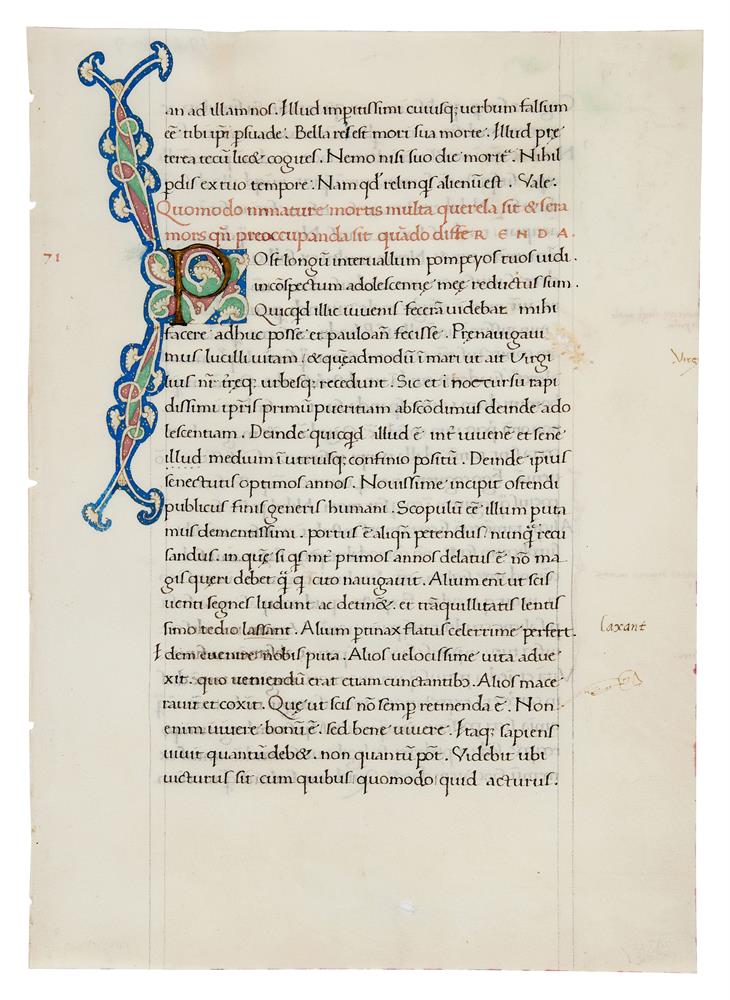SENECA, Lucius Annaeus. (4 BC-AD 65) -- ERASMUS, Desiderius, editor (1466?-1536). [ Opera philosophica ]. Basel: Froben, 1515.
SENECA, Lucius Annaeus. (4 BC-AD 65) -- ERASMUS, Desiderius, editor (1466?-1536). [ Opera philosophica ]. Basel: Froben, 1515. 2° (306 x 203mm). Woodcut architectonic title, contents on verso of title within decorative woodcut side panels, dedication a2r and Ee5r within decorative woodcut borders, wood- and metalcut initials, woodcut device on colophon. (Tiny marginal chip to title, marginal repairs to m4 just into text with the loss of a few letters, very short marginal tears to n3, Ee1 and Ff1 but without loss, tiny wormhole from Gg3 to end affecting a few letters, tiny marginal wormhole from beginning through to Z2, large restored tear on s5 affecting several letters.) Contemporary blind-stamped calf over wooden boards from the Parisian workshop of André Boule, with rosette and winged insect rolls enclosing a central panel with that on the upper cover depicting martyrdom of St Sebastian (Gid and Laffitte 1997, pl. 195, no. 20), the lower cover with a Crucifixion scene with St Thomas and St Catherine of Sienna (Gid and Laffitte 1997, pl. 67, no. 20), with the name 'Andri Boule' beneath, clasps (expertly restored, new endpapers, light stain to lower cover). Provenance : some later ownership entries on lower margin of title page, partly crossed out; the latest entry reads 'Berauld'. FIRST ERASMUS EDITION IN AN IMPORTANT EARLY FRENCH 16TH-CENTURY BINDING SIGNED BY ANDRÉ BOUL E . The famous and prolific printer Johann Froben of Basel was a close friend of Erasmus over many years, and wholeheartedly supported his editorial enterprises. Planned as an anthology of Seneca's works, this book contains the four following texts: 1. Publilius Syrus: Mimi . (VD16 P 5272); 2. Seneca, Lucius Annaeus the elder: Controversiarum libri . (VD16 S 5731); 3. Seneca, Lucius Annaeus the elder: Declamationum libri . (VD16 S 5740); 4. Seneca, Lucius Annaeus the elder: Suasoriarum liber . (VD16 S 5749). By the end of the fifteenth century, bookbinders were seeking ways to save time and labour to meet the demands of increased book production and expanding readership. Several methodological changes were made to increase speed and efficiency, and these included the development of panels and rolls to help speed up the finishing process. Rather than creating a cover design by repeated stamping with small tools, the binder could use a roll to run a line of decoration in a single pass, and a panel stamp could be used in a press to make a complete cover design from a single impression. Flemish binders took the lead in the use of panels, and the technique spread across Europe in the early sixteenth century. Both panels and rolls were skillfully made, engraved or cast with abstract floral designs, depictions of biblical scenes, representations of various virtues, or portraits of contemporary notable persons such as Erasmus, Luther, and Melanchthon. The present lot is an important binding by the Parisian bookbinder André Boule, active in Paris between 1513 and 1523. Cf. Paris, BnF, RES-E*-68(1) and (2), containing two works by Jean Buridan, printed in 1513. Adams S-883; USTC no. 667432; VD16 S 5758 (uniting VD16: P5272, S5731, S5740 and S5749); D.F.S. Thomson, 'Erasmus and Textual Scholarship in the Light of Sixteenth-Century Practice', in: Erasmus of Rotterdam, the man and the scholar: proceedings of the symposium held at the Erasmus University , Rotterdam 9-11 November 1986, edited by Jan Sperna Veiland and Willem Th.M. Frijhoff, Leiden 1988, pp. 158-171.
SENECA, Lucius Annaeus. (4 BC-AD 65) -- ERASMUS, Desiderius, editor (1466?-1536). [ Opera philosophica ]. Basel: Froben, 1515.
SENECA, Lucius Annaeus. (4 BC-AD 65) -- ERASMUS, Desiderius, editor (1466?-1536). [ Opera philosophica ]. Basel: Froben, 1515. 2° (306 x 203mm). Woodcut architectonic title, contents on verso of title within decorative woodcut side panels, dedication a2r and Ee5r within decorative woodcut borders, wood- and metalcut initials, woodcut device on colophon. (Tiny marginal chip to title, marginal repairs to m4 just into text with the loss of a few letters, very short marginal tears to n3, Ee1 and Ff1 but without loss, tiny wormhole from Gg3 to end affecting a few letters, tiny marginal wormhole from beginning through to Z2, large restored tear on s5 affecting several letters.) Contemporary blind-stamped calf over wooden boards from the Parisian workshop of André Boule, with rosette and winged insect rolls enclosing a central panel with that on the upper cover depicting martyrdom of St Sebastian (Gid and Laffitte 1997, pl. 195, no. 20), the lower cover with a Crucifixion scene with St Thomas and St Catherine of Sienna (Gid and Laffitte 1997, pl. 67, no. 20), with the name 'Andri Boule' beneath, clasps (expertly restored, new endpapers, light stain to lower cover). Provenance : some later ownership entries on lower margin of title page, partly crossed out; the latest entry reads 'Berauld'. FIRST ERASMUS EDITION IN AN IMPORTANT EARLY FRENCH 16TH-CENTURY BINDING SIGNED BY ANDRÉ BOUL E . The famous and prolific printer Johann Froben of Basel was a close friend of Erasmus over many years, and wholeheartedly supported his editorial enterprises. Planned as an anthology of Seneca's works, this book contains the four following texts: 1. Publilius Syrus: Mimi . (VD16 P 5272); 2. Seneca, Lucius Annaeus the elder: Controversiarum libri . (VD16 S 5731); 3. Seneca, Lucius Annaeus the elder: Declamationum libri . (VD16 S 5740); 4. Seneca, Lucius Annaeus the elder: Suasoriarum liber . (VD16 S 5749). By the end of the fifteenth century, bookbinders were seeking ways to save time and labour to meet the demands of increased book production and expanding readership. Several methodological changes were made to increase speed and efficiency, and these included the development of panels and rolls to help speed up the finishing process. Rather than creating a cover design by repeated stamping with small tools, the binder could use a roll to run a line of decoration in a single pass, and a panel stamp could be used in a press to make a complete cover design from a single impression. Flemish binders took the lead in the use of panels, and the technique spread across Europe in the early sixteenth century. Both panels and rolls were skillfully made, engraved or cast with abstract floral designs, depictions of biblical scenes, representations of various virtues, or portraits of contemporary notable persons such as Erasmus, Luther, and Melanchthon. The present lot is an important binding by the Parisian bookbinder André Boule, active in Paris between 1513 and 1523. Cf. Paris, BnF, RES-E*-68(1) and (2), containing two works by Jean Buridan, printed in 1513. Adams S-883; USTC no. 667432; VD16 S 5758 (uniting VD16: P5272, S5731, S5740 and S5749); D.F.S. Thomson, 'Erasmus and Textual Scholarship in the Light of Sixteenth-Century Practice', in: Erasmus of Rotterdam, the man and the scholar: proceedings of the symposium held at the Erasmus University , Rotterdam 9-11 November 1986, edited by Jan Sperna Veiland and Willem Th.M. Frijhoff, Leiden 1988, pp. 158-171.









.jpg)


Testen Sie LotSearch und seine Premium-Features 7 Tage - ohne Kosten!
Lassen Sie sich automatisch über neue Objekte in kommenden Auktionen benachrichtigen.
Suchauftrag anlegen